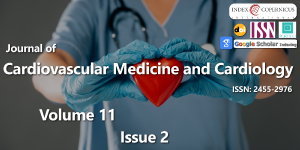The Cardiovascular Effects of Treatment with Atropine 0.01% Eyedrops to prevent the Progression of Childhood Myopia Cardiovascular effects of treatment with atropine 0.01% in children
Main Article Content
Abstract
Abstract
The effectiveness of atropine eyedrops in preventing myopia progression in children has been confirmed, but cardiovascular effects have never been analysed. The objective of this study was to assess cardiovascular changes after treatment with atropine 0.01% eyedrops in 60 paediatric patients who were treated with atropine eyedrops due to myopic progression. Patients were analysed before treatment and 3 months after starting 1 drop daily. The parameters assessed were cardiovascular constants and electrocardiographic data.
The average age was 10.2 years, with a higher women percentage. The average follow-up period was 3.5 months. No patients presented pathological electrocardiographic findings and one patient reported symptoms: palpitations. A statistically significant decrease in heart rate (79 vs. 75 bpm) was reported, but without clinical significance. No changes in blood pressure were observed.
In conclusion, chronic therapy with low doses of atropine as a treatment for myopia progression does not result in pathological heart changes.
Downloads
Article Details
Copyright (c) 2024 Cavero-Roig L, et al.

This work is licensed under a Creative Commons Attribution 4.0 International License.
Huang J, Wen D, Wang Q, McAlinden C, Flitcroft I, Chen H, et al. Efficacy comparison of 16 interventions for myopia control in children: a network meta-analysis. Ophthalmology. 2016;123(4):697-708. Available from: https://doi.org/10.1016/j.ophtha.2015.11.010
Moriche-Carretero M, Revilla-Amores R, Gutiérrez-Blanco A, Moreno-Morillo FJ, Martinez-Perez C, Sánchez-Tena MÁ, et al. Five-year results of atropine 0.01% efficacy in the myopia control in a European population. Br J Ophthalmol. 2024;108(5):715-719. Available from: https://doi.org/10.1136/bjo-2022-322808
Chia A, Chua WH, Cheung YB, Wong WL, Lingham A, Fong A, et al. Atropine for the treatment of childhood myopia: safety and efficacy of 0.5%, 0.1%, and 0.01% doses (Atropine for the Treatment of Myopia 2). Ophthalmology. 2012;119(2):347-354. Available from: https://doi.org/10.1016/j.ophtha.2011.07.031
Gong Q, Janowski M, Luo M, Wei H, Chen B, Yang G, et al. Efficacy and adverse effects of atropine in childhood myopia: a meta-analysis. JAMA Ophthalmol. 2017;135(6):624-630. Available from: https://doi.org/10.1001/jamaophthalmol.2017.1091
Vidhya C, Murali K, Sowmya R. Safety and efficacy of reconstituted atropine 0.01% eye drops for Indian children with myopic progression. Asian J Ophthalmol. 2020;17(2):209-215. Available from: https://doi.org/10.35119/asjoo.v17i2.572
Gong Q, Liu L. Therapeutic effect of atropine 1% in children with low myopia. JAAPOS. 2016;20(4):379. Available from: https://www.jaapos.org/article/S1091-8531(16)00085-9/fulltext
Pérez-Flores I, Macías-Murelaga B, Multicenter Group of Atropine Treatment for Myopia Control (GTAM), Barrio-Barrio J. Age-related results over 2 years of the multicenter Spanish study of atropine 0.01% in childhood myopia progression. Sci Rep. 2023;13(1):16310. Available from: https://doi.org/10.1038/s41598-023-43569-x
Kaila T, Korte JM, Saari KM. Systemic bioavailability of ocularly applied 1% atropine eyedrops. Acta Ophthalmol Scand. 1999;77(2):193-196. Available from: https://doi.org/10.1034/j.1600-0420.1999.770215.x
Jones P, Peters MJ, Pinto da Costa N, Kurth T, Alberti C, Kessous K, et al. Atropine for critical care intubation in a cohort of 264 children and reduced mortality unrelated to effects on bradycardia. PLoS One. 2013;8(2). Available from: https://doi.org/10.1371/journal.pone.0057478
Eisa L, Passi Y, Lerman J, Raczka M, Heard C. Do small doses of atropine (<0.1 mg) cause bradycardia in young children? Arch Dis Child. 2015;100(7):684-688. Available from: https://doi.org/10.1136/archdischild-2014-307868
Fleming S, Thompson M, Stevens R, Heneghan C, Plüddemann A, Maconochie I, et al. Normal ranges of heart rate and respiratory rate in children from birth to 18 years of age: a systematic review of observational studies. Lancet. 2011;377(9770):1011-1018. Available from: https://doi.org/10.1016/s0140-6736(10)62226-x
O'Leary F, Hayen A, Lockie F, Peat J. Defining normal ranges and centiles for heart and respiratory rates in infants and children: a cross-sectional study of patients attending an Australian tertiary hospital paediatric emergency department. Arch Dis Child. 2015;100(8):733-737. Available from: https://doi.org/10.1136/archdischild-2014-307401





